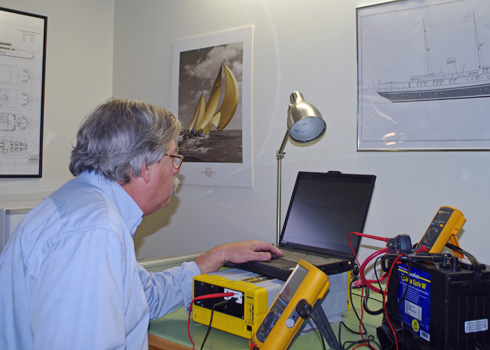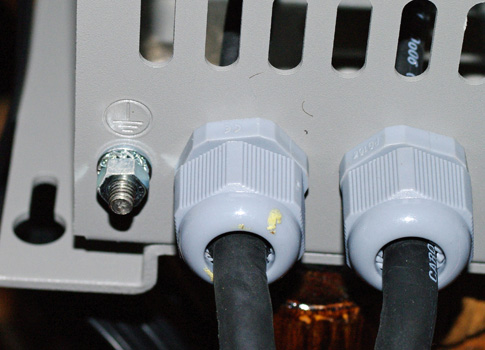Photo courtesy of Ed Sherman

A couple of our ongoing tests are literally spilling over (coffee anyone?) into the world of products still dominated by home appliances, bringing up the subject of inverters that convert your boats 12-volt, direct-current (DC) system to alternating-current (AC) system like those found in our homes. As the trend toward off-the-grid living grows (solar panels, wind generators, and fuel cells produce DC current) so does the list of appliances that run directly off of DC power.
This is good for sailors because each conversion results in energy losses-in some cases, as high as 40 percent. The crazy thing is that many of our home electronics (think of all those little power bricks cluttering up the home office) nativelyrunon DC. By some estimates, in the average American home, 5 percent of the energy bill goes to paying for power that is wasted during the AC-to-DC conversion.
Onboard our boats, the percentage of waste is potentially far higher, as the energy needed to print a few pages goes through three conversions (DC to AC to DC) and the energy lost represents a much higher ratio of our daily usage total. That’s something to think about the next time you dig deep into your pocket for one of our top-rated AGM batteries.
Thankfully, a lot of rechargeable, battery-operated devices we use frequently on board, such as handheld VHFs and LED spotlights, come with plug-in DC chargers (although we’re not big fans of the cigarette-lighter connection). The point is, as we creep closer and closer to a DC-current world (the kind Edison originally envisioned), an onboard inverter – even the most efficient ones from our February 2010 inverter test–make less and less sense.
The one arena where AC still rules is with power tools. Although weve tested a range of battery-operated tools that can tackle minor boat projects, I still havent met an affordable battery-operated disc grinder, skill saw, or heavy-duty drill suitable for the prolonged duty cycles we need. For serious work in remote locales, we can turn to portable generators like the Honda EU1001 that circumnavigators EvansStarzingerand Beth Leonard reported on for Practical Sailor.
Nevertheless, I recognize there are still people out there who are accustomed to having three-pronged holes on their boat and the appliances that require them. If you are in the market for a new inverter or inverter-charger, the following PS Advisor from our archives offers some good advice on installation, and our 2010 inverter-charger test reportoffers some excellent guidance.
Installing a DC inverter isn’t for the faint-hearted, but certainly it can be done. Remember that youre dealing with the potential for a deadly electrical shock. Most units come with clear instructions, and of course, each will vary somewhat, so we wont address specific installations, but rather the general errors that are made in this process.
To find out where most boat owners go wrong in this process, we knocked on the doors of several well-respected boat yards in the New England area and asked their electrical installers what common installation faults they encounter with DIY DC inverter installations. We also asked them for any useful tips about this delicate topic. Almost everyone we spoke with told us that it is essential to install that little safety sticker that comes with every inverter: Warning! Electrical Shock Hazard. This electrical system is equipped with a DC to AC power inverter. Disconnect all electrical sources including the inverters AC and DC inputs before servicing the vessels electrical system.
The safety sticker should be adhered directly to the AC breaker panel. Weve heard plenty of stories of how service techs have gone down to a vessel to solve some DC wiring problem, unplugged the AC dock cord, and next thing they know, theyre being bit by AC voltage as their hand tool inadvertently shorts out a presumably unenergized line. This can be very dangerous. One knowledgeable marine technician told us to make sure that we use a digital voltmeter that measures AC voltage in RMS values if we wanted to get an accurate reading of the inverters AC voltage output. Apparently, if you measure a modified sine-wave inverters output with a low-cost digital voltmeter (non-RMS capable), the reading that you will observe will be 2- to 5-percent lower than actual.
Ed Sherman

Another topic that marine electrical pros feel passionate about is the DC grounding of the inverters case. It appears that there are a lot of self-installed inverters out there that have not been properly grounded. The chassis ground point on the case of the inverter must be connected to your vessels DC grounding system as recommended by the American Boat and Yacht Council (ABYC), and as outlined clearly in your inverters installation manual. Take the ground seriously, and connect it with 1/0 or larger marine-grade, green-jacketed battery cable.
A couple of these sources also mentioned that most inverters will not survive a momentary reversal of the input polarity. Therefore, our experts strongly suggest that the battery terminal lugs be clearly marked, in the event the battery bank is removed for storage or maintenance, and then, inadvertently lowered back into the battery box 180 degrees backwards with the battery posts facing the wrong way.
And speaking of batteries, the rule of thumb is to buy quality batteries for your inverter bank, and don’t undersize the bank. AGM batteries hold up well under the severe draw and recharge conditions that an inverter will impose. Remember that inverters are DC-hungry and will under perform, if you don’t feed them properly.


































